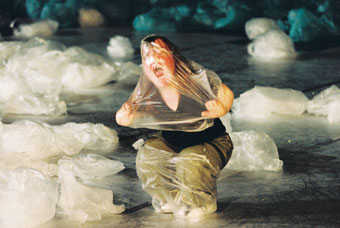To shop, to die (for)
Keith Gallasch

Emma J Cooper, Plaza Real
photo Heidrun Löhr
Emma J Cooper, Plaza Real
Eerily self-contained, the newest agoraphobic shopping malls and vertiginous shopping centres are full of reflective surfaces, fine-grained timbers and stone, classy piped post-muzak, and are replete with comforts and choices that shoppers of yore would not recognise. They can be seductive refuges where the faintest of aberrant behaviour leads to removal. There is no place for the homeless, the loiterer or beggar. Security guards and cleaners clear away all detritus. The pleasures of shopping, of promenading, of relaxing, of being untroubled among your kind is at a premium in these palaces of hygiene and style, communal but not of the community.
Plaza Real is one such centre, realised as performance with all the requisite clarity of intent and stylishness but with the most modest of means—sound, bodies, theatre lights shaped into strict lines and sculpted in an ominous cluster, and a sea of uniformly inflated plastic shopping bags. This is no literal recreation of a shopping centre, but an exquisitely surreal evocation of one in which superficial order and fine design will sooner or later surrender to fundamental passions, where the object is not purchase but the other—desired, fondled, embraced, stalked and attacked. These enactments are just what you won’t encounter in the modern mall, nor are the bursts of monologue, of interiority let loose. Their ironies, uglinesses and despairs are the stuff of art, not shopping. In such circumstances the growing imbalance between order and disintegration yields suspense and surprise as introspection is supplanted by brash extroversion, as touch displaces hostility and embrace turns into dance—beauty where there should be none.
Individuals wander the spaces of Plaza Real or sit and observe, constantly graze fast food, address us as confidantes, play at being entertainers, interact with each other in surprising permutations, commandeer the sound system, disappear into or swim through the plastic until the bags fly into an astonishing rising vortex—a kind of catharsis as the order of shopping is obliterated, a dream as good as any. These are individuals marked by sharp differences of physique and physiognomy, colour, accent and stature, the starkness of their separation broken as they come together.
Martin del Amo approaches us first with a long list of desires (mostly of affluence but peppered with sex with football teams etc) but the banality rises to the sharply satirical as he hilariously dresses us, in his imagination, in a totality of contemporary leisure clothing as rigidly coded as any suit. Later in the performance he dances his familiar blend of reflective langour and embodied, unspecified yearning, mapping out this shopping space as if a place never to be arrived at…or left. Emma J Cooper, a potent performer refuses an interrogation that tries to score existential hits. An actor of short stature, she produces brief dances of arching and dipping that suggest in their precision a resolute sense of self and sensuality. Her finely tuned duet with Keith Lim is like a slow mobile pieta of caring and attentiveness between strangers, an unconscious act. NOMise also figures strongly, another fine mover, restless, threatening and sexy, a self-conscious, self-parodying narcissist, a rap poet, finally revealing himself to be “a Palestinian born in Lebanon, raised in the US of Australia…can’t fly a plane, but labelled as a terrorist every single day.” Valerie Berry is as admirable a mover as ever, if less certainly granted a memorable persona. Like Tadeusz Kantor before him, but less subtly interventionist, director Lee Wilson prowls the performance space, watching, questioning, disrupting, forcing submission.
Not surprisingly, given Mirabelle Wouters’ and Lee Wilson’s background, Plaza Real appears to be a child of Belgium’s Les Ballets C de la B. As in that company’s Terminus, the scenario is of figures locked together, yoked in conflict and compassion in a series of associative performance images with suspense at a premium as the line between the apparently real and the fictional constantly shifts. Plaza Real is a gentler work, one without the risks that Les Ballets C de la B embrace, but with its own distinctiveness. I relished the too rare moments of total ensemble here, of the kind that the Belgian company excels at, a great joyful coming together that could have overpowered the relentless anomie of the shopping mall. The old performance standbys of lists and interrogations are tired and Wilson’s role is just too indeterminate, and the work palpably loses its shape towards the end, but Plaza Real adds up to something very special, as disturbing as the very spaces it critiques.
Branch Nebula’s Mirabelle Wouters and Lee Wilson have combined with Urban Theatre Projects and its artistic director Alicia Talbot (as dramaturg) to create a work that, like its plastic bags, threatens to fly away at any moment, airy and mysterious, while at other times doggedly literal, hard-nosed and plainly satirical. Somewhere in between, strong performers, great design and potent images yield a performance language of great power and promise. An ensemble like this, so very different from those of Version 1.0 and De Quincey Co, would be a great asset for Sydney if it became ongoing. Wouters’ design acumen, her lighting and the poetry and precision of Wilson’s directing in tandem with their joint choreography have wrought a memorable work from a strong cast.
Branch Nebula and Urban Theatre Projects, Plaza Real, co-creators Lee Wilson, Mirabelle Wouters, dramaturg Alicia Talbot, sound designer Phil Downing; Performance Space, Sept 30-Oct 10
RealTime issue #64 Dec-Jan 2004 pg. 44






